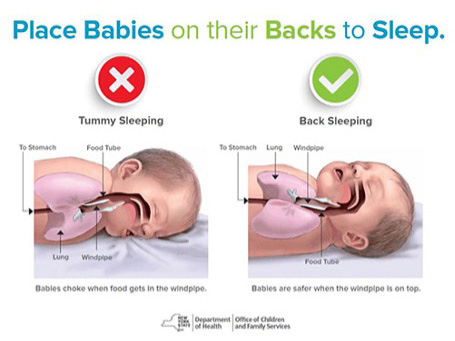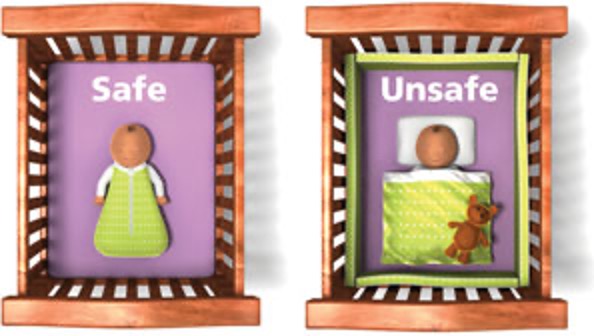Safe sleep for babies
Myths about safe sleeping practices

Myth: Babies are less likely to choke when they are on their stomachs.
Fact: When sleeping on their tummies, babies can choke if food gets in their windpipes. Babies are safer sleeping on their back, when the windpipe is on top.
Myth: Babies are more comfortable on their stomach.
Fact: Babies are comfortable on their back.
Myth: Babies are safer when they share the same bed as the parent/caregiver.
Fact: Your baby is safest in its own crib or bassinet.
Myth: Co-sleeping (the baby sleeps in the same bed as the parent/caregiver) is a time for bonding.
Fact: There are other ways aside from co-sleeping to bond with your baby when you are awake.
Myth: Parents believe if their previous baby did not die from (Sudden Infant Death Syndrome) SIDS, this baby will not either.
Fact: Any baby is at risk for SIDS even though your previous child did not die from SIDS.

Myth: Pillows, rolls, and wedges around the baby make the baby safer.
Fact: Pillows, rolls, and wedges around your baby increases the baby’s risk of SIDS and they do not help your baby sleep better or keep your baby more comfortable.
Myth: Soft blankets, bumpers, and excessive blankets help the baby to sleep better, keep the baby more comfortable, and protect the baby from the cold.
Fact: Using too many blankets does not protect your baby from the cold or keep them more comfortable. Using too many blankets can overheat your baby and could accidentally suffocate them in their sleep. It is recommended you use a sleep sack or two swaddling blankets to keep your baby safe.
All of the above statements are myths. They are not proven by evidence.
References:
- Caraballo, M., Shimasaki, S., Johnston, K., Tung, G., Albright, K., & Halbower, A. C. (2016). Knowledge, attitudes, and risk for sudden unexpected infant death in children of adolescent mothers: A qualitative study. Journal of Pediatrics, 174, 78-83. doi:10.1016/j.jpeds.2016.03.031
- Chu, T., Hackett, M., & Kaur, N. (2015). Exploring caregiver behavior and knowledge about unsafe sleep surfaces in infant injury death cases. Health Education & Behavior, 42(3), 293-301. doi:10.1177/1090198114547817
- Colson, E. R., Levenson, S., Rybin, D., Calianos, C., Margolis, A., Colton, T., Lister, G., Corwin, M. J. (2006). Barriers to following the supine sleep recommendation among mothers at four centers for the women, infants, and children program. Pediatrics, 118(2), e243-250. doi:10.1542/peds.2005-2517
- Hauck, F. R., Tanabe, K. O., McMurry, T., & Moon, R. Y. (2015). Evaluation of bedtime basics for babies: A national crib distribution program to reduce the risk of sleep-related sudden infant deaths. J Community Health, 40(3), 457-463. doi:10.1007/s10900-014-9957-0
- Herman, S., Adkins, M., & Moon, R. Y. (2015). Knowledge and beliefs of african-american and american indian parents and supporters about infant safe sleep. J Community Health, 40(1), 12-19. doi:10.1007/s10900-014-9886-y

